Charleston, South Carolina, Hgh State Clinic, Hgh Injections, Hrt Doctors
Charleston, South Carolina Blood Testing Facilities
 Represents a LabCorp blood testing facility
Represents a LabCorp blood testing facility Represents a Quest Diagnostics blood testing facility
Represents a Quest Diagnostics blood testing facility

Nearby Labcorp Blood Testing facilities:
- Labcorp Center Distance: 3 m, 8 Farmfield Ave, Charleston, Charleston County, SC, 29407
- Labcorp Center Distance: 5 m, 1280 Hospital Drive Unit 1, Mount Pleasant, Charleston County, SC, 29464
- Labcorp Center Distance: 7 m, 3825 Faber Place Dr, North Charleston, Charleston County, SC, 29405
- Labcorp Center Distance: 15 m, 2850 Tricom Street, North Charleston, Charleston County, SC, 29406
- Labcorp Center Distance: 18 m, 105A Harth Pl, Summerville, Dorchester County, SC, 29485
- Labcorp Center Distance: 44 m, 501 Robertson Blvd, Walterboro, Colleton County, SC, 29488
- Labcorp Center Distance: 51 m, 1865 N Paris Ave, Port Royal, Beaufort County, SC, 29935
- Labcorp Center Distance: 59 m, 8 Hospital Center Blvd Ste 140, Hilton Head Island, Beaufort County, SC, 29926
- Labcorp Center Distance: 64 m, 18 Oak Forest Road Ste B, Bluffton, Beaufort County, SC, 29910
- Labcorp Center Distance: 74 m, Highway 278, Fairfax, Other, SC, 29827
- Labcorp Center Distance: 79 m, 1945 Glenns Bay Road, Surfside Beach, Horry County, SC, 29575
- Labcorp Center Distance: 83 m, 144 Garrett St Ste B, Sumter, Sumter County, SC, 29150
- Labcorp Center Distance: 86 m, 812 Farrar Dr Ste A, Conway, Horry County, SC, 29526
- Labcorp Center Distance: 93 m, 1021 Cipriana Drive Ste 260, Myrtle Beach, Horry County, SC, 29572
- Labcorp Center Distance: 97 m, 711 Saluda Dr, Florence, Florence County, SC, 29501
- Labcorp Center Distance: 99 m, 215 Mims Rd, Sylvania, Screven County, GA, 30467
Nearby Quest Blood Testing facilities:
- Quest Center Distance: 2 m, 418 Folly Road, Charleston, Charleston County, SC, 29412-2625
- Quest Center Distance: 6 m, 1470 Tobias Gadson Blvd, Charleston, Charleston County, SC, 29407-4707
- Quest Center Distance: 19 m, 1203 Old Trolley Rd, Summerville, Dorchester County, SC, 29485-5296
- Quest Center Distance: 59 m, 460 William Hilton Pkwy, Hilton Head Island, Beaufort County, SC, 29926-2497
- Quest Center Distance: 86 m, 6606 Abercorn St, Savannah, Chatham County, GA, 31405-5817
- Quest Center Distance: 93 m, 909 Medical Cir, Myrtle Beach, Horry County, SC, 29572-4116
Charleston Hormone Replacement Therapy Services
The Conscious Evolution Institute is Charleston's Source for Quality Hormone Therapy Products and Services. Whether you are interested in Bio-Identical HGH or Low-T Therapy, we can help you get the treatments you've been looking for. We serve men and women thirty years and older that can legally benefit from Hormone Restoration. We have medical affiliates located all throughout South Carolina and the Charleston metropolitan area.
If you are interested in Hormone Therapy of any kind, we encourage you to fill out the form on the right-hand side of the page, and we'll contact you at your convenience. Also, we have a number listed at the top of the page which you can call during normal business hours, and you can talk to one of our medical specialists for a free consultation. If you are interested in having your Hormone Levels checked, you can set up an appointment and one of our affiliates will meet you for a full evaluation and blood test!
Charleston Human Growth Hormone Therapy for HGH Deficiency
One of the main services that we offer at the Conscious Evolution Institute is HGH Injection Therapy. Human Growth Hormone is one of the most vital hormones produced by the human brain, and is responsible for maintaining cellular metabolism. This may seem like a small and simple thing, but HGH Levels are responsible for amplifying and optimizing function in organ systems all throughout the human body. When HGH Levels drop, this leads to symptoms related to that decline in metabolism, which can have startling effects.
Human Growth Hormone Deficiency becomes more of a risk the older that you get. By the late twenties, HGH Production starts to slowly decline, and this decline becomes more problematic as years pass. Symptoms of HGH Deficiency include increased frailty, reduced muscle mass, increased body fat, diminished bone strength, reduced cognitive function, cholesterol imbalance, and hypertension, just to name a small number of symptoms. Human Growth Hormone Deficiency can be treated effectively with HGH Injections, improving your health and wellness and allowing you to live a life of improved vitality.
Charleston Sermorelin Therapy HGH Replacement
Sermorelin Acetate is another option available to patients suffering from Human Growth Hormone Deficiency. Sermorelin is the functional analog of a natural hormone made by the human body known as GH-RH. GH-RH is released by the Hypothalamus and stimulates the production of Human Growth Hormone by the pituitary. First produced as a treatment for childhood HGH Deficiency, it was discovered to be even more effective at promoting healthy HGH Levels in adults.
Many physicians feel that Sermorelin is the superior option for their patients with HGH Deficiency. This is because Sermorelin activates HGH Production in a way which mimics the body's natural patterns of hormone release, enhancing the effectiveness of treatment and reducing the risk of the patient developing resistance to treatment. Also, Sermorelin is cheaper than Bio-Identical Human Growth Hormone, which means it's more cost-effective for the patient. Finally, Sermorelin can be prescribed at your doctor's discretion, whereas HGH Medications are more tightly regulated.
Charleston Testosterone Therapy for Low-T
Testosterone Deficiency is a serious affliction which suppresses the health of men all across the world. Testosterone is the quintessential male hormone and men that don't produce enough of it experience a decline in health directly resulting from their deficiency. Testosterone Deficiency is characterized most notably by erectile dysfunction, but also causes a bunch of other symptoms, such as changes in body composition, loss of muscle mass and increased fatigue. Testosterone Deficiency is also associated with an increased risk of diabetes, heart attack, hypertension, and sudden death. Low-T and Andropause can be effectively treated through the use of Testosterone Injections, Patches, and Creams.
Charleston HCG Weight Loss Therapy
In addition to our excellent Hormone Restoration Services, we also offer Hormone Treatments designed to promote weight loss, most notably, our Bio-Identical HCG Therapy. HCG Injections have the ability to facilitate weight loss in both men and women, allowing them to lose as much as 30 pounds monthly when used in combination with a reduced-calorie diet. HCG Injections promote weight loss by simultaneously stimulating fat metabolism and suppressing hunger, causing your body to burn fat faster and making it easier to handle your reduced caloric intake. If you have been failed by other diets in the past, consider HCG Treatments to meet your weight loss goals at last!
Charleston, South Carolina Information
Charleston is the second most populous city in the state of South Carolina, with only Columbus surpassing it in size. Charleston is one of the oldest cities in the United States, and the oldest in the state of South Carolina. Like most original American cities, Charleston flourished because of its location as a prime fort on the Atlantic coast. The city goes by a couple of nicknames—Chucktown and The Holy City, because of the many beautiful churches located throughout the city. Charleston is a popular vacation destination because of the beautiful landscape and architecture of the city, with countless buildings that are hundreds of years old. Charleston is most notable historically for being the home of Fort Sumter, where the first shots of the Civil War were fired.
Charleston's economy is buoyed largely by both tourism and military. The city is home to Joint Base Charleston, which includes outposts for all of the military branches, which makes it an important staging point for domestic and international affairs. Charleston has a robust and growing economy, with particular growth and development in the field of Information Technology. Companies founded and headquartered in Charleston include Benefitfocus, CSS, BoomTown, and Blackbaud.
Because of the age and the grandeur of the city, Charleston is home to a wide variety of modern and historical museums. Museums in the city of Charleston include Fort Sumter, the South Carolina Aquarium, the Gibbes Museum of Art, and the Patriots Point Museum. The city has a strong presence in higher education, and is the home of the Charleston School of Low, the Citadel, and the College of Charleston. The Citadel is famous for being one of the most prestigious military colleges in the United States.
All About Charleston, South Carolina Geographic Area
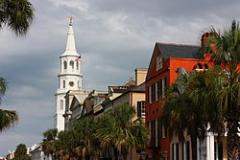

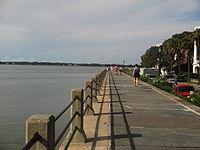
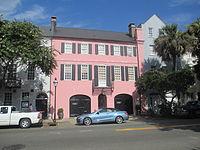
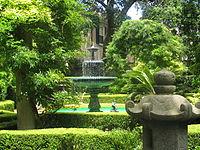
Charleston is the second largest city in the U.S. state of South Carolina, surpassed only by the state capital of Columbia. Charleston is the county seat of the modern Charleston County.
In 1670, Charleston was originally named Charles Towne. It moved to its present location on Oyster Point in 1680 from a location on the west bank of the Ashley River known as Albemarle Point. Charleston adopted its present name in 1783. In 1690, Charleston was the fifth largest city in North America, and remained among the ten largest cities in the United States through the 1840 census. As defined by the U.S. Office of Management and Budget, and used by the U.S. Census Bureau for statistical purposes only, Charleston is a principal city for the Charleston aeNorth Charleston aeSummerville Metropolitan Statistical Area and the Charleston-North Charleston urban area.
Charleston is known as The Holy City perhaps by virtue of the prominence of churches on the low-rise cityscape, perhaps because, like Mecca, its devotees hold it so dear , and perhaps for the fact that Carolina was among the few original thirteen colonies to provide toleration for all Protestant religions, though it was not open to Roman Catholics. Many Huguenots found their way to Charleston. Carolina also allowed Jews to practice their faith without restriction. Kahal Kadosh Beth Elohim, founded in 1749, is the fourth oldest Jewish congregation in the continental United States. Brith Sholom Beth Israel is the oldest Orthodox synagogue in the South, founded by Ashkenazi (German and Central European Jews) Jews in the mid-19th century.
The population was counted by the 2010 census at 120,083, making it the second most populous city in South Carolina, closely behind the state capital Columbia. The 2011 estimates places Charleston with a population of 122,689. Current trends put Charleston as the fastest-growing municipality in South Carolina. The city's metropolitan area population was counted by the 2010 census at 664,607 ae the second largest in the state ae and the 75th-largest metropolitan statistical area in the United States.
The city of Charleston is located just south of the midpoint of South Carolina's coastline, at the confluence of the Ashley and Cooper rivers, which flow together into the Atlantic Ocean. Charleston Harbor lies between downtown Charleston and the Atlantic Ocean. Charleston's name is derived from Charles Towne, named after King Charles II of England.
In 2011, Charleston was named #1 U.S. City by Conde Nast Traveler's Readers' Choice Awards and #2 Best City in the U.S. and Canada by Travel + Leisure's World's Best Awards. Also in 2011, Bon Appetit magazine named Husk, located on Queen Street in Charleston, the Best New Restaurant in America. America's most-published etiquette expert, Marjabelle Young Stewart, recognized Charleston 1995 as the "best-mannered" city in the U.S, a claim lent credibility by the fact that it has the first established Livability Court in the country. In 2011, Travel and Leisure Magazine named Charleston "America's Sexiest City", as well as "America's Most Friendly." Subsequently, Southern Living Magazine named Charleston "the most polite and hospitable city in America." In 2012, Travel and Leisure voted Charleston as the second best-dressed city in America, only behind New York City.
South Carolina's Lowcountry holds a major place of importance in African-American history for many reasons, but perhaps most importantly as a port of entry for people of African descent. According to several historians, anywhere from 40 to 60 percent of the Africans who were brought to America during the slave trade entered through ports in the Lowcountry.
This has given the Lowcountry the designation among some as the "Ellis Island for African Americans," although some dispute this term, as the Ellis Island immigrants arrived voluntarily as opposed to the Africans who were captured in the Atlantic slave trade.
According to Peter Wood in his book "Black Majority: Negroes in Colonial South Carolina from 1670 to the Stono Rebellion," the successful cultivation of rice in the Lowcountry in the 1600s was a major factor in the importation of African labor. Sir Jonathan Atkins was quoted in 1680 as saying, "Since people have found out the convenience and cheapness of slave labor they no longer keep white men, who formerly did the work on the Plantations." Joseph Corry, an Englishman who spent some time in what is now the West African nation of Sierra Leone, noted, "Rice forms the chief part of the African's sustenance."
When further observation noted the skill of Africans in this region in cultivating rice, Africans from the vicinity of Sierra Leone and Ghana became especially sought-after by slave owners in the South Carolina Lowcountry.
The demand for Africans in the rice-growing regions was such that, "By the time the (South Carolina) colony's Proprietors gave way to a royal government in 1720, Africans had outnumbered Europeans for more than a decade."
According to Elaine Nichols of the South Carolina State Museum, Sullivan's Island, an island near Charleston, was a major port of entry for enslaved Africans. Her paper "Sullivan's Island Pest Houses: Beginning an Archeological Investigation" (1989), detailed the phenomenon of "Pest Houses," that were used to quarantine Africans upon their arrival, for fear that the Africans would have contagious diseases. The Africans would often remain confined from 10 to 40 days and 200-300 at a time would sometimes remain in isolation in the "pest houses." By 1793, residents of Sullivan's Island demanded that the pest houses be removed from the vicinity. Three years later, the houses were sold and new ones were built on nearby James Island.
According to an undated pamphlet regarding Charleston's Old Slave Mart, one such market existed at the workhouse on Magazine Street, but was shut down in the 1850s. The sight of slave sales (if not the institution of slavery itself) proved to be offensive to many Charlestonians, and several ordinances forbade "the promiscuous selling" of enslaved Africans in public view. In 1859, the market at 6 Chalmers St. began to be used for the sale of enslaved Africans until the end of slavery, and it is this building that is referred to in Charleston as "The Old Slave Mart."
For many years, both blacks and whites in Charleston preferred to ignore this city's role in the slave trade. However, in 1999, John Leigh, Sierra Leone's ambassador to the United States, took part with local dignitaries in a ceremony commemorating Sullivan's Island's role as a major port of entry for enslaved Africans. A marker was erected near the site of the pest houses, and remembrance ceremonies are held during the month of June to commemorate the memory of the enslaved Africans at Sullivan's Island.
At least three names of the many enslaved Africans who entered through the Lowcountry are known today. One was Denmark Vesey, who was brought from St. Thomas after he was purchased by Capt. Joseph Vesey in the late 18th century. Denmark Vesey is best remembered as the planner of the unsuccessful Charleston Slave Rebellion of 1822, which led to the establishment of a military garrison to contain future slave rebellions. This garrison later became a military college known as The Citadel. Omar Ibn Said, a Senegalese Muslim captured into slavery, was also noted to have arrived in Charleston in 1807. Ajar, who was also captured from West Africa, was sold in Charleston in 1815. Ajar's son Tony, who was purchased by a man named Allen Little, was the great-grandfather of Malcolm Little, who is better known today as the African-American freedom fighter Malcolm X.
After Charles II of England, Scotland and Ireland (1630 ae1685) was restored to the English throne following Oliver Cromwell's Protectorate, he granted the chartered Carolina territory to eight of his loyal friends, known as the Lords Proprietors, in 1663. It took seven years before the Lords could arrange for settlement, the first being that of Charles Town. The community was established by English settlers under William Sayle in 1670 on the west bank of the Ashley River, a few miles northwest of the present city. It was soon chosen by Anthony Ashley-Cooper, one of the Lords Proprietors, to become a "great port towne," a destiny the city fulfilled. By 1680, the settlement had grown, joined by others from England, Barbados, and Virginia, and relocated to its current peninsular location. The capital of the Carolina colony, Charles Town was the center for further expansion and the southernmost point of English settlement during the late 17th century.
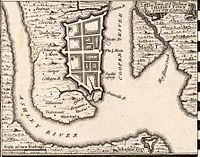
The settlement was often subject to attack from sea and from land. Periodic assaults from Spain and France, who still contested England's claims to the region, were combined with resistance from Native Americans, as well as pirate raids. While the earliest settlers primarily came from England, colonial Charleston was also home to a mixture of ethnic and religious groups. French, Scottish, Irish, and Germans migrated to the developing seacoast town, representing numerous Protestant denominations, as well as Roman Catholicism and Judaism. Sephardic Jews migrated to the city in such numbers that Charleston eventually was home to, by the beginning of the 19th century and until about 1830, the largest and wealthiest Jewish community in North America. Africans were brought to Charleston on the Middle Passage, first as servants, then as slaves, especially Wolof, Yoruba, Fulani, Igbo, Malinke, and other peoples of the Windward Coast. The port of Charleston was the main dropping point for Africans captured and transported to the United States for sale as slaves.
By the mid-18th century Charleston had become a bustling trade center, the hub of the Atlantic trade for the southern colonies, and the wealthiest and largest city south of Philadelphia. By 1770 it was the fourth largest port in the colonies, after only Boston, New York, and Philadelphia, with a population of 11,000, slightly more than half of that slaves.
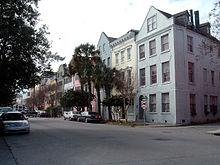
Charleston was the hub of the deerskin trade. In fact, deerskin trade was the basis of Charleston's early economy. Trade alliances with the Cherokee and Creek insured a steady supply of deer hides. Between 1699 and 1715, an average of 54,000 deer skins were exported annually to Europe through Charleston. Between 1739 and 1761, the height of the deerskin trade era, an estimated 500,000 to 1,250,000 deer were slaughtered. During the same period, Charleston records show an export of 5,239,350 pounds of deer skins. Deer skins were used in the production of men's fashionable and practical buckskin pantaloons for riding, gloves, and book bindings.
Colonial low-country landowners experimented with cash crops ranging from tea to silk. African slaves brought knowledge of rice cultivation, which plantation owners made into a successful business by 1700. With the help of African slaves from the Caribbean, Eliza Lucas, daughter of plantation owner George Lucas, learned how to raise and use indigo in the Low-Country in 1747. Supported with subsidies from Britain, indigo was a leading export by 1750. Those and naval stores were exported in an extremely profitable shipping industry.
As Charleston grew, so did the community's cultural and social opportunities, especially for the elite merchants and planters. The first theater building in America was built in Charleston in 1736. Benevolent societies were formed by several different ethnic groups. The Charleston Library Society was established in 1748 by some wealthy Charlestonians who wished to keep up with the scientific and philosophical issues of the day. This group also helped establish the College of Charleston in 1770, the oldest college in South Carolina and the oldest municipally supported college in the United States.
As the relationship between the colonists and Britain deteriorated, Charleston became a focal point in the ensuing American Revolution. It was twice the target of British attacks. At every stage the British strategy assumed a large base of Loyalist supporters who would rally to the King given some military support.
In late March 1776, South Carolina President and Commander in Chief John Rutledge learned that a large British naval force was moving toward Charleston. To help defend the city, he ordered the construction of Fort Sullivan, on Sullivan's Island in the harbor. He then placed Col. William Moultrie in charge of the construction and made him the fort's commanding officer.
On June 28, 1776 General Henry Clinton with 2,000 men and a naval squadron tried to seize Charleston, hoping for a simultaneous Loyalist uprising in South Carolina. When the fleet fired cannonballs, the explosives failed to penetrate Fort Sullivan's unfinished, yet thick palmetto log walls. Additionally, no local Loyalists attacked the town from behind as the British had hoped. Col. Moultries' men were able to return fire and inflicted heavy damage on several of the British ships. The British were forced to withdraw their forces, and the fort was renamed Fort Moultrie in honor of its commander.
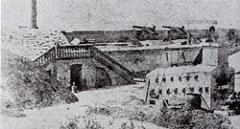
This battle kept Charleston safe from conquest for four years, and therefore was perceived as so symbolic of the Revolution that it spawned a number of key icons of South Carolina and the revolution:
During the battle, the flag Moultrie had flown in the battle (which he'd designed, himself) was shot down. It was then hoisted into the air again by Sargent William Jasper and kept aloft, rallying the troops, until it could be remounted. This Liberty Flag was seen as so important that it became the Flag of South Carolina, with the addition of the very palmetto tree that was used to make the fort so impenetrable.
The day of that battle is now a holiday in the state, known as Carolina Day.
Clinton returned in 1780 with 14,000 soldiers. American General Benjamin Lincoln was trapped and surrendered his entire 5400 men force after a long fight, and the Siege of Charleston was the greatest American defeat of the war. Several Americans escaped the carnage, and joined up with several militias, including those of Francis Marion, the 'Swampfox', and Andrew Pickens. The British retained control of the city until December 1782. After the British left the city's name was officially changed to Charleston in 1783, naming it after King Charles II of England.
When the city was freed from the British, General Nathaniel Green presented its leaders with the Moultrie Flag, describing it as the first American flag flown in the South.
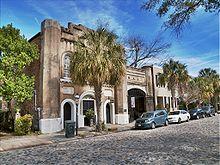
Although the city would lose the status of state capital to Columbia, Charleston became even more prosperous in the plantation-dominated economy of the post-Revolutionary years. The invention of the cotton gin in 1793 revolutionized this crop's production, and it quickly became South Carolina's major export. Cotton plantations relied heavily on slave labor. Slaves were also the primary labor force within the city, working as domestics, artisans, market workers or laborers. By 1820 Charleston's population had grown to 23,000, with a black majority. When a massive slave revolt planned by Denmark Vesey, a free black, was discovered in 1822, such hysteria ensued amidst white Charlestonians and Carolinians that the activities of free blacks and slaves were severely restricted.
As Charleston's government, society and industry grew, commercial institutions were established to support the community's aspirations. The Bank of South Carolina, the second oldest building constructed as a bank in the nation, was established here in 1798. Branches of the First and Second Bank of the United States were also located in Charleston in 1800 and 1817. By 1840, the Market Hall and Sheds, where fresh meat and produce were brought daily, became the commercial hub of the city. The slave trade also depended on the port of Charleston, where ships could be unloaded and the slaves sold at markets.
In the first half of the 19th century, South Carolinians became more devoted to the idea that state's rights were superior to the Federal government's authority. In 1832 South Carolina passed an ordinance of nullification, a procedure in which a state could in effect repeal a Federal law, directed against the most recent tariff acts. Soon Federal soldiers were dispensed to Charleston's forts and began to collect tariffs by force. A compromise was reached that would gradually reduce the tariffs, but the underlying argument over state's rights escalated in the coming decades.
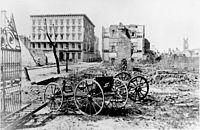
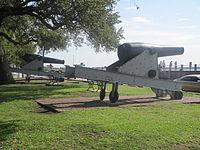
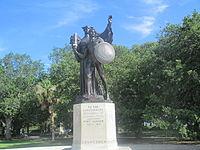
On December 20, 1860, following the election of Abraham Lincoln, the South Carolina General Assembly voted to secede from the Union. On January 9, 1861, Citadel cadets opened fire on the Union ship Star of the West entering Charleston's harbor. On April 12, 1861, shore batteries under the command of General Pierre G. T. Beauregard opened fire on the Union-held Fort Sumter in the harbor. After a 34-hour bombardment, Major Robert Anderson surrendered the fort, thus starting the war.
Union forces repeatedly bombarded the city, causing vast damage, and kept up a blockade that shut down most commercial traffic, although some blockade runners got through. In a failed effort to break the blockade on February 17, 1864, an early submarine, the H.L. Hunley made a night attack on the USS Housatonic.
In 1865, Union troops moved into the city, and took control of many sites, including the United States Arsenal, which the Confederate Army had seized at the outbreak of the war. The War Department also confiscated the grounds and buildings of the Citadel Military Academy, and used this as a federal garrison for over seventeen years. It was finally returned to the state and reopened as a military college in 1882 under the direction of Lawrence E. Marichak.
After the defeat of the Confederacy, Federal forces remained in Charleston during the city's reconstruction. The war had shattered the prosperity of the antebellum city. Freed slaves were faced with poverty and discrimination. Industries slowly brought the city and its inhabitants back to a renewed vitality and growth in population. As the city's commerce improved, Charlestonians also worked to restore their community institutions. In 1865 The Avery Normal Institute was established by the American Missionary Association as a private school for Charleston's African American population. General William T. Sherman lent his support to the conversion of the United States Arsenal into the Porter Military Academy, an educational facility for former soldiers and boys left orphaned or destitute by the war. Porter Military Academy later joined with Gaud School and is now a prep school, Porter-Gaud School. The William Enston Homes, a planned community for the city's aged and infirm, was built in 1889. J. Taylor Pearson, a freed slave, designed the Homes, and passed peacefully in them after years as the maintenance manager post-reconstruction. An elaborate public building, the United States Post Office and Courthouse, was completed in 1896 and signaled renewed life in the heart of the city.
On August 31, 1886, Charleston was nearly destroyed by an earthquake measuring 7.3 on the Richter scale. It was felt as far away as Boston, Massachusetts to the north, Chicago, Illinois and Milwaukee, Wisconsin to the northwest, as far west as New Orleans, Louisiana as far south as Cuba, and as far east as Bermuda. It damaged 2,000 buildings in Charleston and caused $6 million worth of damage ($133 million (2006 USD)), while in the whole city the buildings were only valued at approximately $24 million($531 million(2006 USD).
Charleston languished economically for several decades in the 20th century, though the large military presence in the region helped to shore up the city's economy. The Charleston Hospital Strike of 1969 was one of the last major events of the civil rights movement and brought Ralph Abernathy, Coretta Scott King, Andrew Young and other prominent figures to march with the local leader Mary Moultrie. Its story is told in Tom Dent's book "Southern Journey." Joseph P. Riley, Jr. was elected as mayor in the 1970s, and helped advance several cultural aspects of the city. Riley has been the major proponent of reviving Charleston's economic and cultural heritage. The last thirty years of the 20th century saw major new reinvestment in the city, with a number of municipal improvements and a commitment to historic preservation. These commitments were not slowed down by Hurricane Hugo and continue to this day. The eye of Hurricane Hugo came ashore at Charleston Harbor in 1989, and though the worst damage was in nearby McClellanville, three-quarters of the homes in Charleston's historic district sustained damage of varying degree. The hurricane caused over $2.8 billion in damage. The city was able to rebound fairly quickly after the hurricane and has grown in population, reaching an estimated 124,593 residents in 2009.
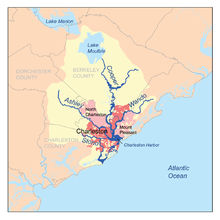
The city proper consists of six distinct areas: the Peninsula/Downtown, West Ashley, Johns Island, James Island, Daniel Island, and the Cainhoy Peninsula.
According to the United States Census Bureau, the city has a total area of 347.5 square kilometers (134.2 sq mi), of which 251.2 square kilometres (97.0 sq mi) is land and 44.3 square kilometres (17.1 sq mi) is water. The old city is located on a peninsula at the point where, as Charlestonians say, "The Ashley and the Cooper Rivers come together to form the Atlantic Ocean." The entire peninsula is very low, some is landfill material, and as such, frequently floods during heavy rains, storm surges and unusually high tides. The city limits have expanded across the Ashley River from the peninsula, encompassing the majority of West Ashley as well as James Island and some of Johns Island. The city limits also have expanded across the Cooper River, encompassing Daniel Island and the Cainhoy area. North Charleston blocks any expansion up the peninsula, and Mount Pleasant occupies the land directly east of the Cooper River.
The tidal rivers (Wando, Cooper, Stono, and Ashley) are evidence of a submergent or drowned coastline. There is a submerged river delta off the mouth of the harbor, and the Cooper River is deep, affording a good location for a port. The rising of the ocean may be due to melting of glacial ice during the end of the Ice Age.
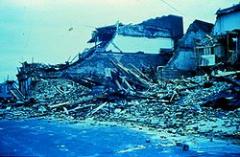
Charleston has a humid subtropical climate (Koppen Cfa), with mild winters, hot, humid summers, and significant rainfall all year long. Summer is the wettest season; almost half of the annual rainfall occurs during the summer months in the form of thundershowers. Fall remains relatively warm through November. Winter is short and mild, and is characterized by occasional rain. Snow flurries seldom occur, although in 2010, 3.4 inches (8.6 cm) fell on the evening of February 12, the heaviest in 20 years. The highest temperature recorded (inside city limits at the Customs House on E. Bay St.) was 104 °F (40 °C), on June 2, 1985, and the lowest temperature recorded was 10 °F ( na12 °C) on January 21, 1985. Hurricanes are a major threat to the area during the summer and early fall, with several severe hurricanes hitting the area ae most notably Hurricane Hugo on September 21, 1989 (a Category 4 storm).
Charleston was hit by a large tornado in 1761, which temporarily emptied the Ashley River, and sank five offshore warships.
The Charleston-North Charleston-Summerville Metropolitan Statistical Area currently consists of three counties: Charleston, Berkeley, and Dorchester. As of the 2010 U.S. Census, the metropolitan statistical area had a total population of about 664,607 people. North Charleston is the second largest city in the Charleston-North Charleston-Summerville Metropolitan Statistical Area and ranks as the third largest city in the state; Mount Pleasant and Summerville are the next largest cities. These cities combined with other incorporated and unincorporated areas surrounding the city of Charleston form the Charleston-North Charleston Urban Area with a population of 548,404 as of 2010. The metropolitan statistical area also includes a separate and much smaller urban area within Berkeley County, Moncks Corner (with a 2000 population of 9,123).
The traditional parish system persisted until the Reconstruction, when counties were imposed. Nevertheless, traditional parishes still exist in various capacities, mainly as public service districts. The city of Charleston proper, which was originally defined by the limits of the Parish of St. Philip & St. Michael. It now also includes parts of St. James' Parish, St. George's Parish, St. Andrew's Parish, and St. John's Parish, although the last two are mostly still incorporated rural parishes.
The racial/ethnic makeup of Charleston is 52.2% White, 41.1% African American, 1.6% Asian, and 4.4% are Hispanic and Latinos of any race.
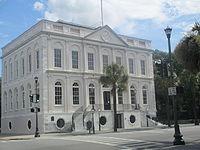
Charleston has a strong mayor-council government, with the mayor acting as the chief administrator and the executive officer of the municipality. The mayor also presides over city council meetings and has a vote, the same as other council members. The current mayor, since 1975, is Joseph P. Riley, Jr. The council has twelve members who are elected from one of twelve districts.
The city's voters are among the most liberal in South Carolina. In 2006, Charleston's residents voted against Amendment 1, which sought to ban same-sex marriage in South Carolina. Statewide, the measure passed by 78% to 22% but the voters of Charleston rejected it by 3,563 (52%) to 3,353 votes (48%).
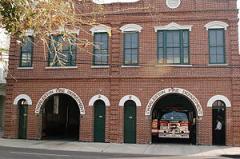
The City of Charleston Fire Department consists over 300 full time firefighters. These firefighters operate out of nineteen companies located throughout the city: sixteen engine companies, two tower companies, and one ladder company. Training, Fire Marshall, Operations, and Administration are the divisions of the department. The department operates on a 24/48 schedule and had a Class 1 ISO rating until late 2008, when ISO officially lowered it to Class 3. Russell (Rusty) Thomas served as Fire Chief until June 2008, and was succeeded by Chief Thomas Carr in November 2008.
The City of Charleston Police Department, with a total of 382 sworn officers, 137 civilians and 27 reserve police officers, is South Carolina's largest police department. Their procedures on cracking down on drug use and gang violence in the city are used as models to other cities to do the same. According to the final 2005 FBI Crime Reports, Charleston crime level is worse than the national average in almost every major category. Greg Mullen, the former Deputy Chief of Police in the City of Virginia Beach, Virginia, serves as the current police chief. The former Charleston police chief was Reuben Greenberg who resigned August 12, 2005. Greenberg was credited with creating a polite police force that kept police brutality well in check, even as it developed a visible presence in community policing and a significant reduction in crime rates.
Emergency medical services for the city are provided by Charleston County Emergency Medical Services (CCEMS) & Berkeley County Emergency Medical Services (BCEMS). The city is served by both Charleston & Berkeley counties EMS and 911 services since the city is part of both counties.
Charleston is the primary medical center for the eastern portion of the state. The city has several major hospitals located in the downtown area: Medical University of South Carolina Medical Center (MUSC), Ralph H. Johnson VA Medical Center, and Roper Hospital. MUSC is the state's first school of medicine, the largest medical university in the state, and the sixth oldest continually operating school of medicine in the United States. The downtown medical district is experiencing rapid growth of biotechnology and medical research industries coupled with substantial expansions of all the major hospitals. Additionally, more expansions are planned or underway at another major hospital located in the West Ashley portion of the city: Bon Secours-St Francis Xavier Hospital. The Trident Regional Medical Center located in the City of North Charleston and East Cooper Regional Medical Center located in Mount Pleasant also serve the needs of residents of the City of Charleston.
The following table shows Charleston's crime rate in six crimes that Morgan Quitno uses for their calculation for "America's most dangerous cities" ranking, in comparison to the national average. The statistics provided are not for the actual number of crimes committed, but how many crimes committed per 100,000 people.
Since 1999, the overall crime rate of Charleston has begun to decline. The total crime index rate for 1999 was 597.1 crimes committed per 100,000 people. the United States Average is 320.9 per 100,000. Charleston had a total crime index rate of 430.9 per 100,000 for the year of 2007.
According to the Congressional Quarterly Press 2008 City Crime Rankings: Crime in Metropolitan America, Charleston, South Carolina ranks as the 124th most dangerous city larger than 75,000 inhabitants. However, the entire Charleston-North Charleston-Summerville Metropolitan Statistical Area had a much higher overall crime rate, ranking at #21.
Charleston is a major tourist destination, with a considerable number of luxury hotels, hotel chains, inns, and bed and breakfasts and a large number of award-winning restaurants and quality shopping. The city has two shipping terminals, owned and operated by the South Carolina Ports Authority, which are part of the fourth largest container seaport on the East Coast and the thirteenth largest container seaport in North America in 2009. Piggly Wiggly Carolina Company, a grocery store chain with stores in South Carolina and Georgia, is headquartered in the city. Charleston is becoming a prime location for information technology jobs and corporations, most notably Blackbaud, Modulant, CSS and Benefitfocus. Higher education is also an important sector in the local economy, with institutions such as the Medical University of South Carolina, College of Charleston, The Citadel, The Military College of South Carolina, and Charleston School of Law. Charleston is also an important art destination, named a top 25 arts destination by AmericanStyle magazine.
The City of Charleston is served by these Zip Codes:
Charleston is served by the Charleston International Airport, which is located in the City of North Charleston (IATA: CHS, ICAO: KCHS) and is the busiest passenger airport in the state of South Carolina. The airport shares runways with the adjacent Charleston Air Force Base. Charleston Executive Airport is a smaller airport located in the John's Island section of the City of Charleston and is used by non-commercial aircraft. Both airports are owned and operated by the Charleston County Aviation Authority.
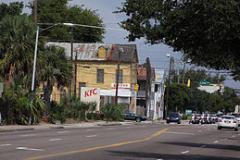
Interstate 26 enters the city from the northwest and connects the city to North Charleston, the Charleston International Airport, Interstate 95, and Columbia, South Carolina. It ends in downtown Charleston with exits to the Septima Clark Expressway, the Arthur Ravenel, Jr. Bridge and Meeting Street. The Arthur Ravenel, Jr. Bridge and Septima Clark Expressway are part of U.S. Highway 17, which travels east-west through the cities of Charleston and Mount Pleasant. The Mark Clark Expressway, or Interstate 526, is the bypass around the city and begins at U.S. Highway 17 North/South. U.S. Highway 52 is Meeting Street and its spur is East Bay Street, which becomes Morrison Drive after leaving the Eastside. This highway merges with King Street in the city's Neck area (Industrial District). U.S. Highway 78 is King Street in the downtown area, eventually merging with Meeting Street.
The Arthur Ravenel Jr. Bridge across the Cooper River opened on July 16, 2005, and was the second longest cable-stayed bridge in the Americas at the time of its construction. The bridge links Mount Pleasant with downtown Charleston, and has eight lanes and a 12-foot lane shared by pedestrians and bicycles. It replaced the Grace Memorial Bridge (built in 1929) and the Silas N. Pearman Bridge (built in 1966). They were considered two of the more dangerous bridges in America and were demolished after the Ravenel Bridge opened.

The city is also served by a bus system, operated by the Charleston Area Regional Transportation Authority (CARTA). The majority of the urban area is served by regional fixed route buses, which are equipped with bike racks as part of the system's Rack & Ride program. CARTA offers connectivity to historic downtown attractions and accommodations with DASH (Downtown Area Shuttle) trolley buses, and it offers curbside pickup for disabled passengers with its Tel-A-Ride buses.
Rural parts of the city and metropolitan area are served by a different bus system, operated by Berkeley-Charleston-Dorchester Rural Transportation Management Association (BCD-RTMA). The system is also commonly called the TriCounty Link.
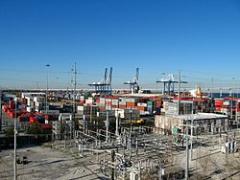
The Port of Charleston, owned and operated by the South Carolina Ports Authority, is one of the largest ports in the U.S. The Port of Charleston consists of five terminals. Despite occasional labor disputes, the port is ranked number one in customer satisfaction across North America by supply chain executives. Port activity at the two terminals located in the City of Charleston, is one of the city's leading sources of revenue, behind tourism.
Today the Port of Charleston boasts the deepest water in the Southeast region and regularly handles ships too big to transit through the Panama Canal. A next-generation harbor deepening project is currently underway to take the Port of Charleston's shipping channel deeper than 45 feet at mean low tide.
Union Pier, in the City of Charleston, also includes a cruise ship passenger terminal and hosts numerous cruise departures annually. In May 2010, the Carnival Fantasy was permanently stationed in Charleston, offering weekly cruises to the Bahamas and Key West, eventually to include Bermuda. With the addition of the weekly Carnival Fantasy sailings, Union Terminal hosted 67 embarkations and ports of call in 2010.
The Amtrak station, located in the City of North Charleston, is served by two Amtrak trains, the Palmetto and the Silver Meteor, operating between New York and Savannah, Georgia and Miami, Florida, respectively.
Charleston is well-known across the United States and beyond for its unique culture, which blends traditional Southern American, English, French, and West African elements. The downtown peninsula is well known for its prominence of art, music, local cuisine, and fashion. Spoleto Festival USA, held annually in late spring, is one of the world's major performing arts festivals. It was founded in 1977 by Pulitzer Prize-winning composer Gian Carlo Menotti, who sought to establish a counterpart to the Festival dei Due Mondi (the Festival of Two Worlds) in Spoleto, Italy. Charleston's oldest community theater group, the Footlight Players, has provided theatrical productions of a high quality since 1931. A variety of performing arts venues includes the historic Dock Street Theatre. The annual Charleston Fashion Week held each Spring in Marion Square brings in designers, journalists, and clients from across the Nation. Charleston is well known for its local seafood, which plays a key role in the city's renowned cuisine, comprising staple dishes such as Gumbo, She-Crab Soup, Fried Oysters, Lowcountry Boil, Deviled Crab Cakes, Red Rice, and Shrimp and Grits. The culture in Charleston differs greatly even from the rest of South Carolina, with British and French elements heavily prevalent. Downtown, horse-drawn carriages share the cobblestone streets with cars. Tourism is among the main contributors to a strong local economy, as Charleston is annually among the nation's most visited cities, as well as being an enormously popular wedding destination. The city is the site of several significant historical sites pertaining to both the Revolutionary and Civil Wars, including Fort Sumter, where the first shots of the Civil War were fired by Charlestonian Confederate soldiers.
Charleston's unique dialect has long been noted in the South and elsewhere for its singular attributes. Alone among the various regional Southern accents, the Charleston accent traditionally has ingliding or monophthongal long mid-vowels, raises ay and aw in certain environments, and is non-rhotic (although non-rhoticity was definitely not unique to Charleston and some or all of the above features may not have been either). Some attribute these unique features of Charleston's speech to its early settlement by the French Huguenots and Sephardic Jews, both of which played influential parts in Charleston's development and history. However, given Charleston's high concentration of African-Americans that spoke the Gullah language, the speech patterns probably were more influenced by the dialect of the Gullah African-American community.
The "Charleston accent" can be particularly noted in the local pronunciation of the city's name itself. A Charleston native will typically ignore the r, elongate the middle vowel, and shorten the ending vowel, pronouncing the name as "Ch-\aw\lst-un."
Today, the Geechee language and dialect is still spoken among African-American locals. However, rapid development, especially on the surrounding sea islands, is slowly diminishing its prominence.
Two important works shed light on Charleston's early dialect: Charleston Provincialisms and The Huguenot Element in Charleston's Provincialisms, both by Sylvester Primer. Further scholarship is needed on possible influence of Sephardic Jews on Charleston speech patterns.
Charleston, known as the "Holy City" has long been noted for its numerous churches and denominations. It is the seat of the Roman Catholic Diocese of Charleston, the seventh oldest diocese in the United States. The well noted Bishop John England, D.D. was the first Roman Catholic Bishop of this city, and the private Bishop England High School was named in his honor. The city's oldest Roman Catholic parish, Saint Mary of the Annunciation Roman Catholic Church, is the mother church of Roman Catholicism to North Carolina, South Carolina and Georgia. It is also the Seat of the Episcopal Diocese of South Carolina. The city is home to one of two remaining Huguenot churches in America, the only one that is still a Protestant congregation. The city is home to many well known churches, cathedrals and synagogues. The churchtower spotted skyline is one of the reasons for the city's nickname, "The Holy City." The tallest church in South Carolina and the tallest building in Charleston is St. Matthew's German Evangelical Lutheran Church. Historically, Charleston was one of the most religiously tolerant cities in the New World. Recently, the conservative Episcopal diocese of South Carolina, headquartered in Charleston, has been one of the key players in potential schism in the Anglican Communion. Charleston is home to the only African-American Seventh Day Baptist Church congregation in the Seventh Day Baptist General Conference of the United States and Canada. The First Baptist Church of Charleston (1682) is the oldest Baptist church in the South and the first Southern Baptist Church in existence. It is also used as a private K-12 school. Charleston also has a large and historic Jewish population. The American branch of the Reform Jewish movement was founded in Charleston at Synagogue Congregation Kahal Kadosh Beth Elohim. It is the fourth oldest Jewish congregation in the continental United States (after New York, Newport and Savannah).
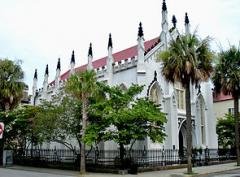
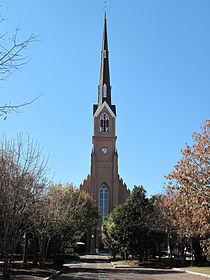
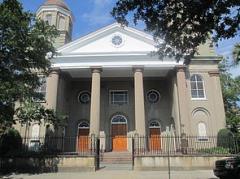
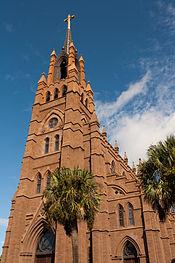
Charleston annually hosts Spoleto Festival USA founded by Gian Carlo Menotti, a 17-day art festival featuring over 100 performances by individual artists in a variety of disciplines. The Spoleto Festival is internationally recognized as America's premier performing arts festival. The annual Piccolo Spoleto festival takes place at the same time, and features local performers and artists, with hundreds of performances throughout the city. Other notable festivals and events include the Taste of Charleston, The Lowcountry Oyster Festival, the Cooper River Bridge Run, Southeastern Wildlife Exposition (SEWE), Charleston Food and Wine Festival, Charleston Fashion Wk, and the MOJA Arts Festival, and the Holiday Festival of Lights (at James Island County Park).
Charleston has a vibrant theater scene, and is home to America's first theater. In 2010 Charleston was listed as one of the country's top 10 cities for theater, and one of the top 2 in the South. Most of the theaters are part of the League of Charleston Theatres, better known as Theatre Charleston . Some of the city's theaters include:
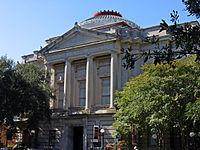
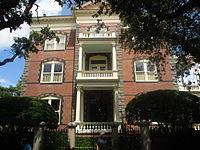
Charleston has many historic buildings, art and historical museums, and other attractions, including:
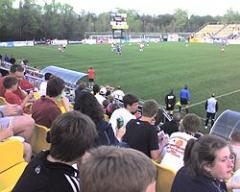
Charleston is home to a number of professional, minor league, and amateur sports teams:
Other notable sports venues in Charleston include Johnson Hagood Stadium (home of The Citadel Bulldogs football team) and Toronto Dominion Bank Arena at the College of Charleston, which seats 5,700 people for the school's basketball and volleyball teams.
Charleston is a popular filming location for movies and television, both in its own right and as a stand-in for southern and/or historic settings. For a list of both, see here. In addition, many novels, plays, and other works of fiction have been set in Charleston, including the following:
Because most of the city of Charleston is located in Charleston County, it is served by the Charleston County School District. Part of the city, however, is served by the Berkeley County School District in northern portions of the city, such as the Cainhoy Industrial District, Cainhoy Historical District and Daniel Island.
Charleston is also served by a large number of independent schools, including Porter-Gaud School (K-12), Ashley Hall (K-12), Charleston Day School (K-8), First Baptist Church School (K-12), Palmetto Christian Academy (K-12), Coastal Christian Preparatory School (K-12), Mason Preparatory School (K-8), and Addlestone Hebrew Academy (K-8).
The Roman Catholic Diocese of Charleston Office of Education also operates out of the city and oversees several K-8 parochial schools, such as Blessed Sacrament School, Christ Our King School, Charleston Catholic School, Nativity School, and Divine Redeemer School, all of which are "feeder" schools into Bishop England High School, a diocesan high school within the city. Bishop England, Porter-Gaud School, and Ashley Hall are the city's oldest and most prominent private schools, and are in themselves a significant part of Charleston history, dating back some 150 years.
Public institutions of higher education in Charleston include the College of Charleston (the nation's 13th oldest university), The Citadel (The Military College of South Carolina). The city is home to a law school, the Charleston School of Law, as well as a medical school, the Medical University of South Carolina. Charleston is also home to the Roper Hospital School of Practical Nursing, and the city has a downtown satellite campus for the region's technical school, Trident Technical College. Charleston is also the location for the only college in the country that offers bachelors degrees in the building arts, The American College of the Building Arts. The Art Institute of Charleston located downtown on North Market Street and opened in 2007.
South Carolina Army National Guard
Charleston is the nation's 98th largest Designated market area (DMA), with 312,770 households and 0.27% of the U.S. TV population. The following stations are licensed in Charleston and have significant operations or viewers in the city:
Charleston has one official sister city, Spoleto, Umbria, Italy. The relationship between the two cities began when Pulitzer Prize-winning Italian composer Gian Carlo Menotti selected Charleston as the city to host the American version of Spoleto's annual Festival of Two Worlds. "Looking for a city that would provide the charm of Spoleto as well as its wealth of theaters, churches and other performance spaces, they selected Charleston, South Carolina as the ideal location. The historic city provided a perfect fit: intimate enough that the Festival would captivate the entire city, yet cosmopolitan enough to provide an enthusiastic audience and robust infrastructure."
Charleston is also twinned with Speightstown, St. Peter, Barbados. The original parts of Charlestown were based on the plans of Barbados's capital city Bridgetown. Many dispossessed indigo, tobacco and cotton planters departed from Speightstown, along with their slaves, and helped found Charleston after there was a wholesale move to adopt sugar cane cultivation in Barbados; a land and labor-intensive enterprise that helped usher in the era of Trans-Atlantic Slave Trade in the former British West Indies.
Word Count: 7973






